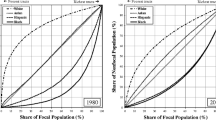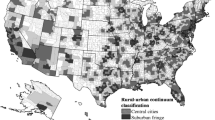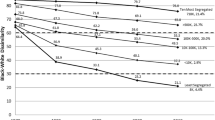Abstract
Data from Census 2000 show that black-white segregation declined modestly at the national level after 1980, while Hispanic and Asian segregation rose in most metropolitan areas. Changes that may have produced greater changes for blacks proved to have insignificant effects: there was no net shift of the black population toward less-segregated areas, segregation at the metropolitan level did not decline more in areas where the incomes of blacks came closer to the incomes of whites over time, and the emergence of more multiethnic metropolises had no impact. As in the past, declines were centered in the South and West and in areas with smaller black populations. Increases in Hispanic and Asian segregation in individual metropolitan areas were counterbalanced by a net movement of these two groups toward areas of lower segregation. These increases were associated especially with the more rapid growth in the Hispanic and Asian populations. Hispanic segregation increased more in regions where group members had declining incomes relative to the incomes of whites and included a growing share of immigrants.
Similar content being viewed by others
References
Alba, R.D., J.R. Logan, and B.J. Stults. 2000. “How Segregated Are Middle-Class African Americans?” Social Problems 47:543–58.
Blalock, H.M. 1967. Toward a Theory of Minority Group Relations. New York: John Wiley and Sons.
Charles, C. Zubrinsky. 2000. “Residential Segregation in Los Angeles.” Pp. 167–219 in Prismatic Metropolis: Inequality in Los Angeles, edited by L.D. Bobo, M.L. Oliver, J.H. Johnston, Jr., and A. Valenzuela, Jr. New York: Russell Sage Foundation.
—. 2001. “Processes of Racial Residential Segregation.” Pp. 217–71 in Urban Inequality: Evidence From Four Cities, edited by A. O’Connor, C. Tilly, and L.D. Bobo. New York: Russell Sage Foundation.
Cheng, L. and P.Q. Yang. 1996. “Asians: The ‘Model Minority’ Deconstructed.” Pp. 305–344 in Ethnic Los Angeles, edited by R. Waldinger and M. Bozorgmehr. New York: Russell Sage Foundation.
Cutler, D.M., E.L. Glaeser, and J.L. Vigdor. 1999. “The Rise and Decline of the American Ghetto.” Journal of Political Economy 107:455–506.
Darden, J.T. and S.M. Kamel. 2000. “Black Residential Segregation in the City and Suburbs of Detroit: Does Socioeconomic Status Matter?” Journal of Urban Affairs 22(1):1–13.
Denton, N.A. and D.S. Massey. 1988. “Residential Segregation of Blacks, Hispanics, and Asians by Socioeconomic Status and Generation.” Social Science Quarterly 69:797–817.
Duncan, O.D. and B. Duncan. 1955. “A Methodological Analysis of Segregation Measures.” American Sociological Review 20:210–17.
Ellen, I. Gould. 2000. Sharing America’s Neighborhoods: The Prospects for Stable Integration. Cambridge, MA: Harvard University Press.
Farley, R. 1977. “Trends in Racial Inequalities: Have the Gains of the 1960s Disappeared in the 1970s?” American Sociological Review 42:189–218.
Farley, R., E.L. Fielding, and M. Krysan. 1997. “The Residential Preferences of Blacks and Whites: A Four-Metropolis Analysis.” Housing Policy Debate 8:763–800.
Farley, R. and W.H. Frey. 1994. “Changes in the Segregation of Whites From Blacks During the 1980s: Small Steps Towards a More Integrated Society.” American Sociological Review 59: 23–45.
Frey, W.H. and R. Farley. 1996. “Latino, Asian, and Black Segregation in U.S. Metropolitan Areas: Are Multiethnic Metros Different?” Demography 33:35–50.
Good, D.L. 1989. Orvie: The Dictator of Dearborn: The Rise and Reign of Orville L. Hubbard. Detroit: Wayne State University Press.
Iceland, J., D.H. Weinberg, and E. Steinmetz. 2002. Racial and Ethnic Segregation in the United States, 1980–2000. U.S. Census Bureau, Series CENSR-3. Washington, DC: U.S. Government Printing Office.
Jakubs, J.F. 1986. “Recent Racial Segregation in U.S. SMSAs.” Urban Geography 7: 146–63.
Johnson, R. and R. Farley. 1985. “On the Statistical Significance of the Index of Dissimilarity.” Proceedings of the Social Statistics Section, American Statistical Association. Washington, DC: American Statistical Association.
Keating, W.D. 1994. The Suburban Racial Dilemma: Housing and Neighborhoods. Philadelphia: Temple University Press.
Krivo, L.J. and R.L. Kaufman. 1999. “How Low Can It Go? Declining Black-White Segregation in a Multiethnic Context.” Demography 36:93–109.
Lewis Mumford Center, University at Albany. 2002. “Metropolitan Racial and Ethnic Change— 2000.” Available on-line at http://www.albany.edu/mumford/census
Logan, J.R., R.D. Alba, and S.-Y. Leung. 1996. “Minority Access to White Suburbs: A Multiregional Comparison.” Social Forces 74:851–81.
Logan, J.R., R.D. Alba, and W. Zhang. 2002. “Immigrant Enclaves and Ethnic Communities in New York and Los Angeles.” American Sociological Review 67:299–322.
Massey, D.S. 1985. “Ethnic Residential Segregation: A Theoretical Synthesis and Empirical Review.” Sociology and Social Science Research 69:315–50.
Massey, D.S. and N.A. Denton. 1987. “Trends in the Residential Segregation of Blacks, Hispanics, and Asians: 1970–1980.” American Sociological Review 52:802–25.
—. 1988. “The Dimensions of Residential Segregation.” Social Forces 67:281–315.
—. 1993. American Apartheid: Segregation and the Making of the Underclass. Cambridge, MA: Harvard University Press.
Massey, D.S. and M.J. Fischer. 1999. “Does Rising Income Bring Integration? New Results for Blacks, Hispanics, and Asians in 1990.” Social Science Research 28:316–26.
Massey, D.S. and A.B. Gross. 1991. “Explaining Trends in Racial Segregation, 1970–1980.” Urban Affairs Quarterly 27:13–35.
Ortiz, V. 1996. “The Mexican-Origin Population: Permanent Working Class or Emerging Middle Class?” Pp. 247–78 in Ethnic Los Angeles, edited by R. Waldinger and M. Bozorgmehr. New York: Russell Sage Foundation.
Patterson, O. 1997. The Ordeal of Integration: Progress and Resentment in America’s “Racial” Crisis. Washington, DC: Civitas/Counterpoint.
Population Studies Center, University of Michigan. 2003. “Racial Residential Segregation: Census 2000 Findings.” Available on-line at http://www.psc.isr.umich.edu/residentialsegregation
Saltman, J. 1990. Neighborhood Stabilization: A Fragile Movement. New York: Greenwood Press.
Schuman, H., C. Steeh, L. Bobo, and M. Krysan. 1998. Racial Attitudes in America: Trends and Interpretations, rev. ed. Cambridge, MA: Harvard University Press.
Social Science Data Analysis Network, University of Michigan. 2001. “Census Scope: Your Portal to Census 2000 Data.” Available on-line at www.censusscope.org
St. John, C. and R. Clymer. 2000. “Racial Residential Segregation by Level of Socioeconomic Status.” Social Science Quarterly 81:701–15.
Taeuber, K. and A. Taeuber. 1965. Negroes in Cities: Residential Segregation and Neighborhood Change. Chicago: Aldine Publishing.
Thernstrom, S. and A. Thernstrom. 1997. America in Black and White: One Nation, Indivisible. New York: Simon and Schuster.
U. S. v. City of Parma, 1981. 494 F. Supp.
U.S. Census Bureau. 1992. Census of Population and Housing, 1990: Summary Tape File 3A. Washington, DC: U.S. Census Bureau.
—. 1993. Census of Population and Housing, 1990: Summary Tape File 4A. Washington, DC: U.S. Census Bureau.
—. 2001a. Census of Population and Housing, 2000: Public Law (P.L.) 94-171 Data. Washington, DC: U.S. Census Bureau.
—. 2001b. Census of Population and Housing, 2000: Summary File 1. Washington, DC: U.S. Census Bureau.
U.S. Census Bureau. 2002. “Historical Income Data.” Available on-line at http://www.census.gov/hhes/income/ histinc/histinctb.html
White, M.J. 1987. American Neighborhoods and Residential Differentiation. New York: Russell Sage Foundation.
White, M.J. and J.E. Glick. 1999. “The Impact of Immigration on Residential Segregation.” Pp. 345–72 in Immigration and Opportunity: Race, Ethnicity, and Employment in the United States, edited by F. Bean and S. Bell-Rose. New York: Russell Sage Foundation.
Wilson, W.J. 1987. The Truly Disadvantaged: The Inner City, the Underclass, and Public Policy. Chicago: University of Chicago Press.
Zoloth, B.S. 1976. Alternative Measures of School Segregation. Madison: Institute for Research on Poverty, University of Wisconsin.
Author information
Authors and Affiliations
Additional information
This research was supported by the Lewis Mumford Center, University at Albany, and by a grant from the Ford Foundation. The Center for Social and Demographic Analysis, University at Albany, provided technical and administrative support through grants from the National Institute of Child Health and Human Development (P30 HD32041) and the National Science Foundation (NSF) (SBR-9512290). Additional support was provided by the Population Studies Center at the University of Michigan and NSF Grant SES-0095658. We thank Jacob Stowell, Deirdre Oakley, and Pamela Bennett for their assistance with the data analysis and Judy Mullin for preparation of the manuscript.
Rights and permissions
About this article
Cite this article
Logan, J.R., Stults, B.J. & Farley, R. Segregation of minorities in the metropolis: two decades of change. Demography 41, 1–22 (2004). https://doi.org/10.1353/dem.2004.0007
Issue Date:
DOI: https://doi.org/10.1353/dem.2004.0007




